Organisational Behaviour Case Study: In-depth Analysis & Solutions
VerifiedAdded on 2023/05/31
|18
|3753
|151
Case Study
AI Summary
This document presents a comprehensive analysis of an organizational behavior case study, addressing key issues such as diversity, the Treaty of Waitangi, organizational alignment, conflict resolution, and employee empowerment. The analysis covers various aspects, including the importance of equal employment opportunities and diversity within the Canterbury District Health Board (CDHB), the rationale behind incorporating Maori perspectives and practices in the workplace, and strategies for aligning organizational goals and addressing conflicts stemming from poor communication and management. Furthermore, it explores empowerment theories and practical approaches to fostering a positive and inclusive team environment. The document also includes recommendations for improving workplace dynamics, promoting cultural awareness, and ensuring fair treatment and opportunities for all employees.
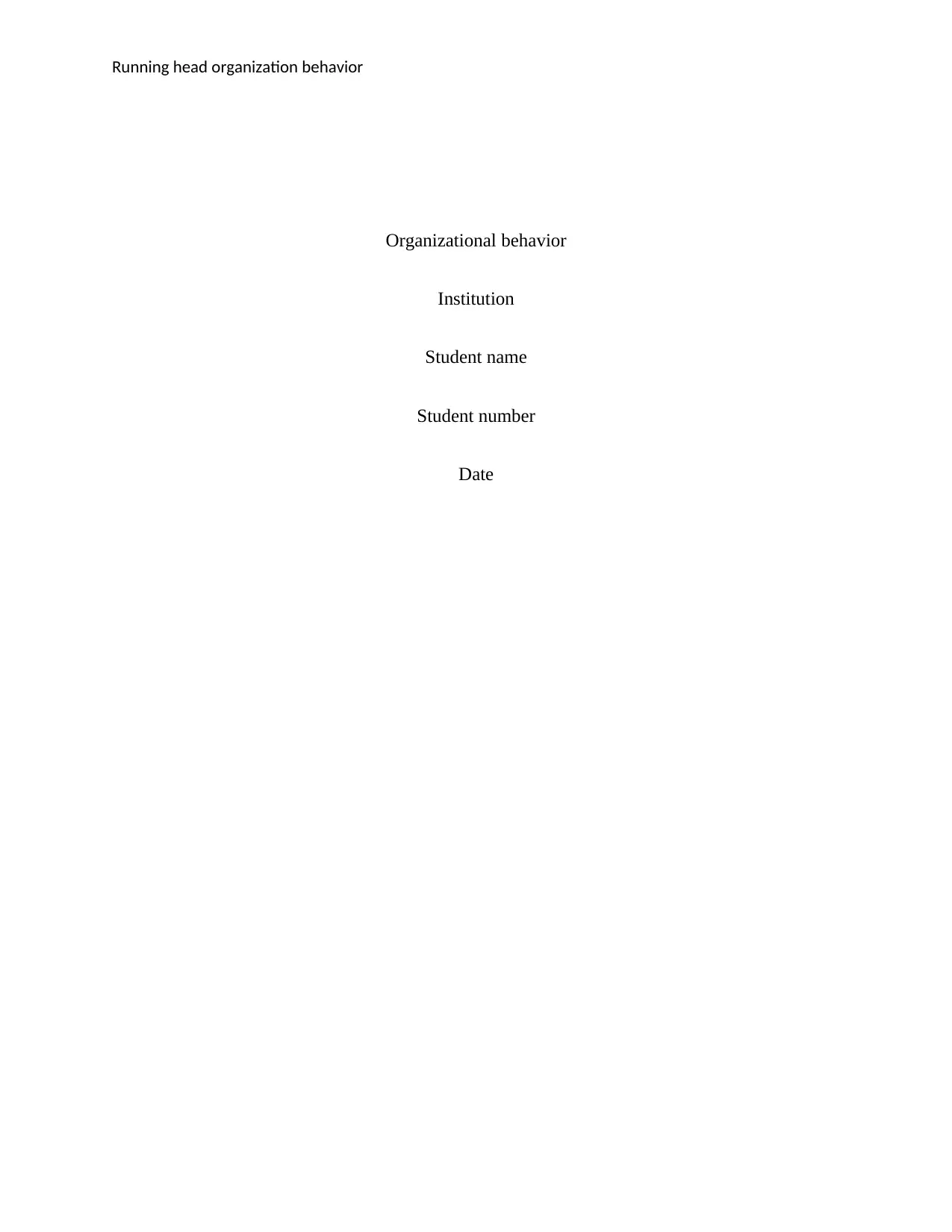
Running head organization behavior
Organizational behavior
Institution
Student name
Student number
Date
Organizational behavior
Institution
Student name
Student number
Date
Paraphrase This Document
Need a fresh take? Get an instant paraphrase of this document with our AI Paraphraser
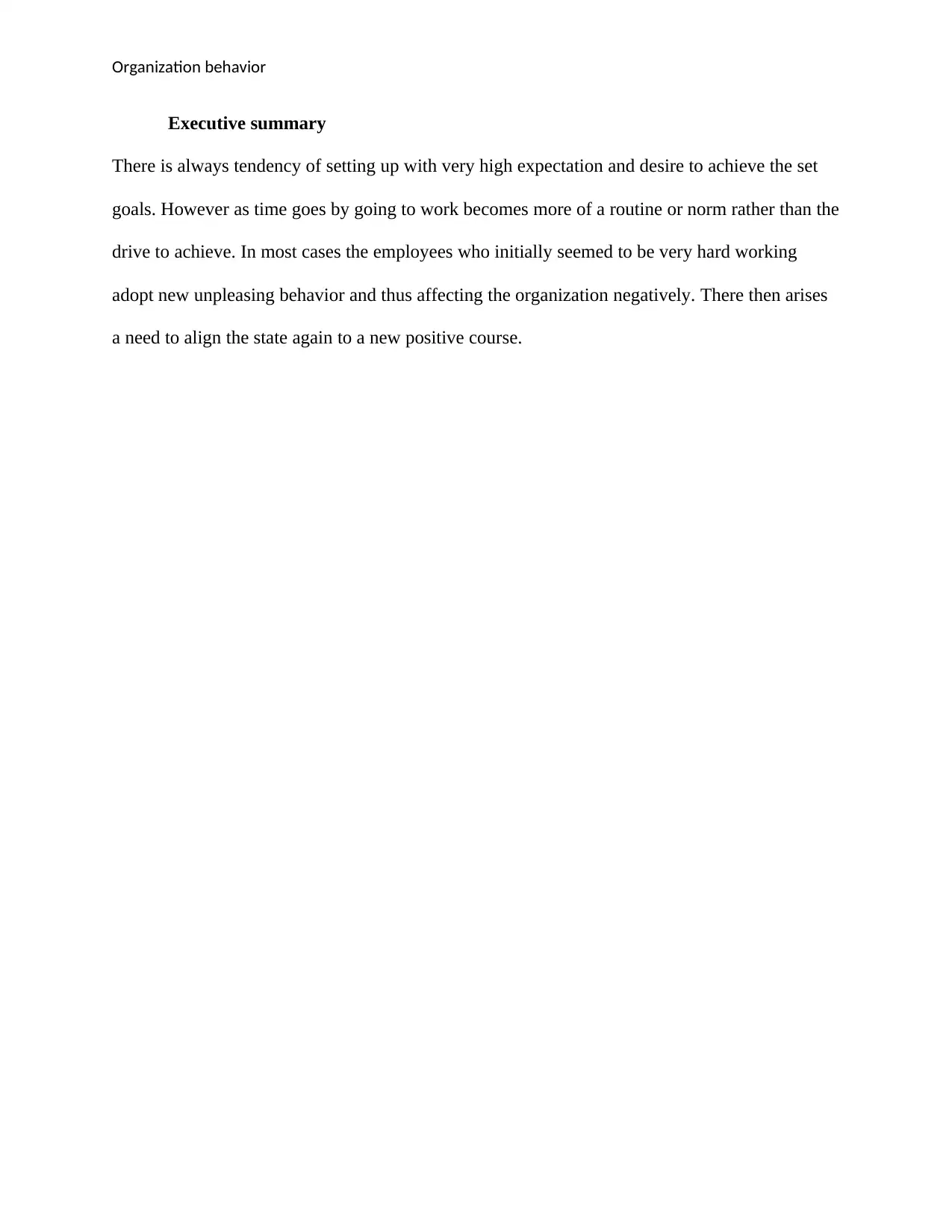
Organization behavior
Executive summary
There is always tendency of setting up with very high expectation and desire to achieve the set
goals. However as time goes by going to work becomes more of a routine or norm rather than the
drive to achieve. In most cases the employees who initially seemed to be very hard working
adopt new unpleasing behavior and thus affecting the organization negatively. There then arises
a need to align the state again to a new positive course.
Executive summary
There is always tendency of setting up with very high expectation and desire to achieve the set
goals. However as time goes by going to work becomes more of a routine or norm rather than the
drive to achieve. In most cases the employees who initially seemed to be very hard working
adopt new unpleasing behavior and thus affecting the organization negatively. There then arises
a need to align the state again to a new positive course.
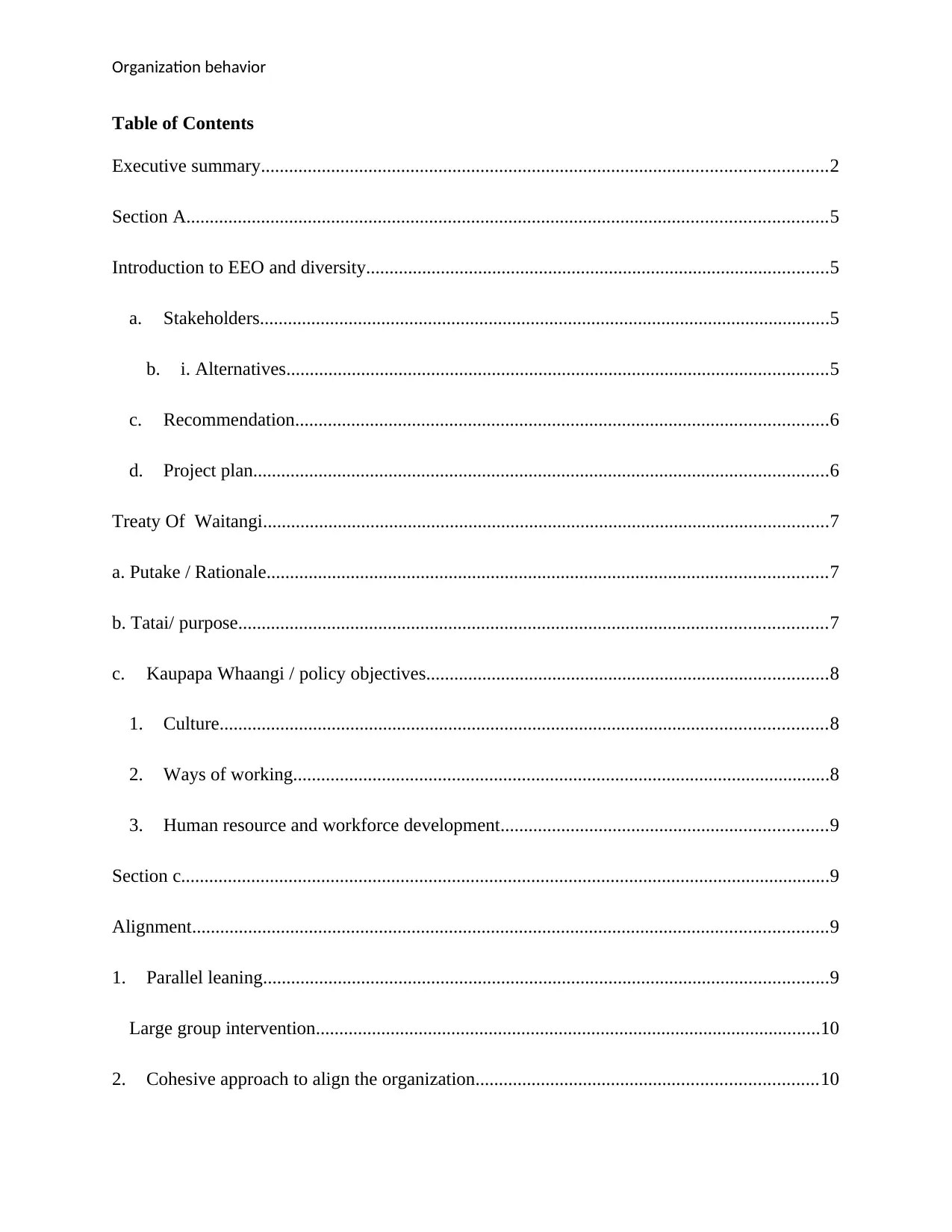
Organization behavior
Table of Contents
Executive summary.........................................................................................................................2
Section A.........................................................................................................................................5
Introduction to EEO and diversity...................................................................................................5
a. Stakeholders..........................................................................................................................5
b. i. Alternatives....................................................................................................................5
c. Recommendation..................................................................................................................6
d. Project plan...........................................................................................................................6
Treaty Of Waitangi.........................................................................................................................7
a. Putake / Rationale........................................................................................................................7
b. Tatai/ purpose..............................................................................................................................7
c. Kaupapa Whaangi / policy objectives......................................................................................8
1. Culture..................................................................................................................................8
2. Ways of working...................................................................................................................8
3. Human resource and workforce development......................................................................9
Section c...........................................................................................................................................9
Alignment........................................................................................................................................9
1. Parallel leaning.........................................................................................................................9
Large group intervention............................................................................................................10
2. Cohesive approach to align the organization.........................................................................10
Table of Contents
Executive summary.........................................................................................................................2
Section A.........................................................................................................................................5
Introduction to EEO and diversity...................................................................................................5
a. Stakeholders..........................................................................................................................5
b. i. Alternatives....................................................................................................................5
c. Recommendation..................................................................................................................6
d. Project plan...........................................................................................................................6
Treaty Of Waitangi.........................................................................................................................7
a. Putake / Rationale........................................................................................................................7
b. Tatai/ purpose..............................................................................................................................7
c. Kaupapa Whaangi / policy objectives......................................................................................8
1. Culture..................................................................................................................................8
2. Ways of working...................................................................................................................8
3. Human resource and workforce development......................................................................9
Section c...........................................................................................................................................9
Alignment........................................................................................................................................9
1. Parallel leaning.........................................................................................................................9
Large group intervention............................................................................................................10
2. Cohesive approach to align the organization.........................................................................10
⊘ This is a preview!⊘
Do you want full access?
Subscribe today to unlock all pages.

Trusted by 1+ million students worldwide
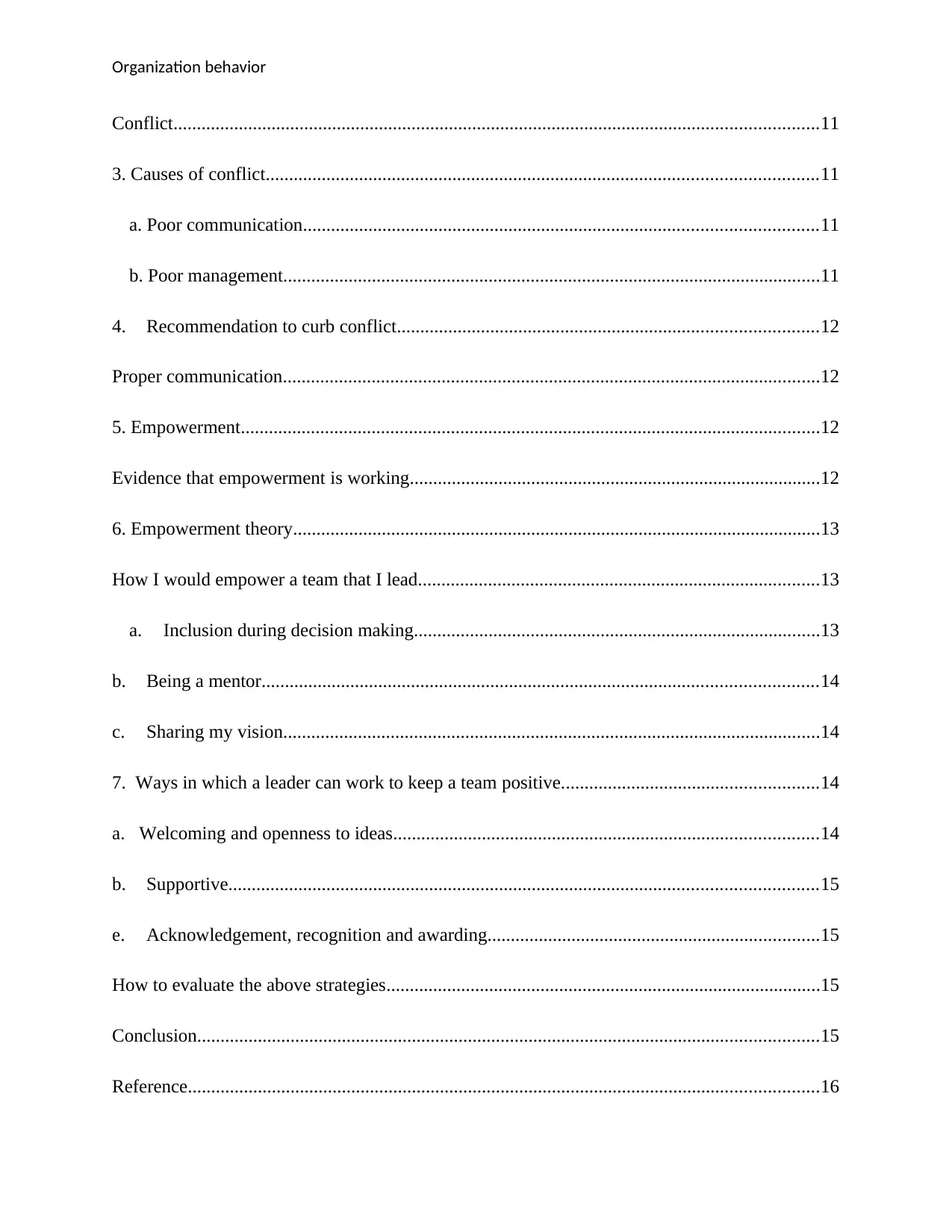
Organization behavior
Conflict..........................................................................................................................................11
3. Causes of conflict......................................................................................................................11
a. Poor communication..............................................................................................................11
b. Poor management...................................................................................................................11
4. Recommendation to curb conflict..........................................................................................12
Proper communication...................................................................................................................12
5. Empowerment............................................................................................................................12
Evidence that empowerment is working........................................................................................12
6. Empowerment theory.................................................................................................................13
How I would empower a team that I lead......................................................................................13
a. Inclusion during decision making.......................................................................................13
b. Being a mentor.......................................................................................................................14
c. Sharing my vision...................................................................................................................14
7. Ways in which a leader can work to keep a team positive.......................................................14
a. Welcoming and openness to ideas...........................................................................................14
b. Supportive..............................................................................................................................15
e. Acknowledgement, recognition and awarding.......................................................................15
How to evaluate the above strategies.............................................................................................15
Conclusion.....................................................................................................................................15
Reference.......................................................................................................................................16
Conflict..........................................................................................................................................11
3. Causes of conflict......................................................................................................................11
a. Poor communication..............................................................................................................11
b. Poor management...................................................................................................................11
4. Recommendation to curb conflict..........................................................................................12
Proper communication...................................................................................................................12
5. Empowerment............................................................................................................................12
Evidence that empowerment is working........................................................................................12
6. Empowerment theory.................................................................................................................13
How I would empower a team that I lead......................................................................................13
a. Inclusion during decision making.......................................................................................13
b. Being a mentor.......................................................................................................................14
c. Sharing my vision...................................................................................................................14
7. Ways in which a leader can work to keep a team positive.......................................................14
a. Welcoming and openness to ideas...........................................................................................14
b. Supportive..............................................................................................................................15
e. Acknowledgement, recognition and awarding.......................................................................15
How to evaluate the above strategies.............................................................................................15
Conclusion.....................................................................................................................................15
Reference.......................................................................................................................................16
Paraphrase This Document
Need a fresh take? Get an instant paraphrase of this document with our AI Paraphraser
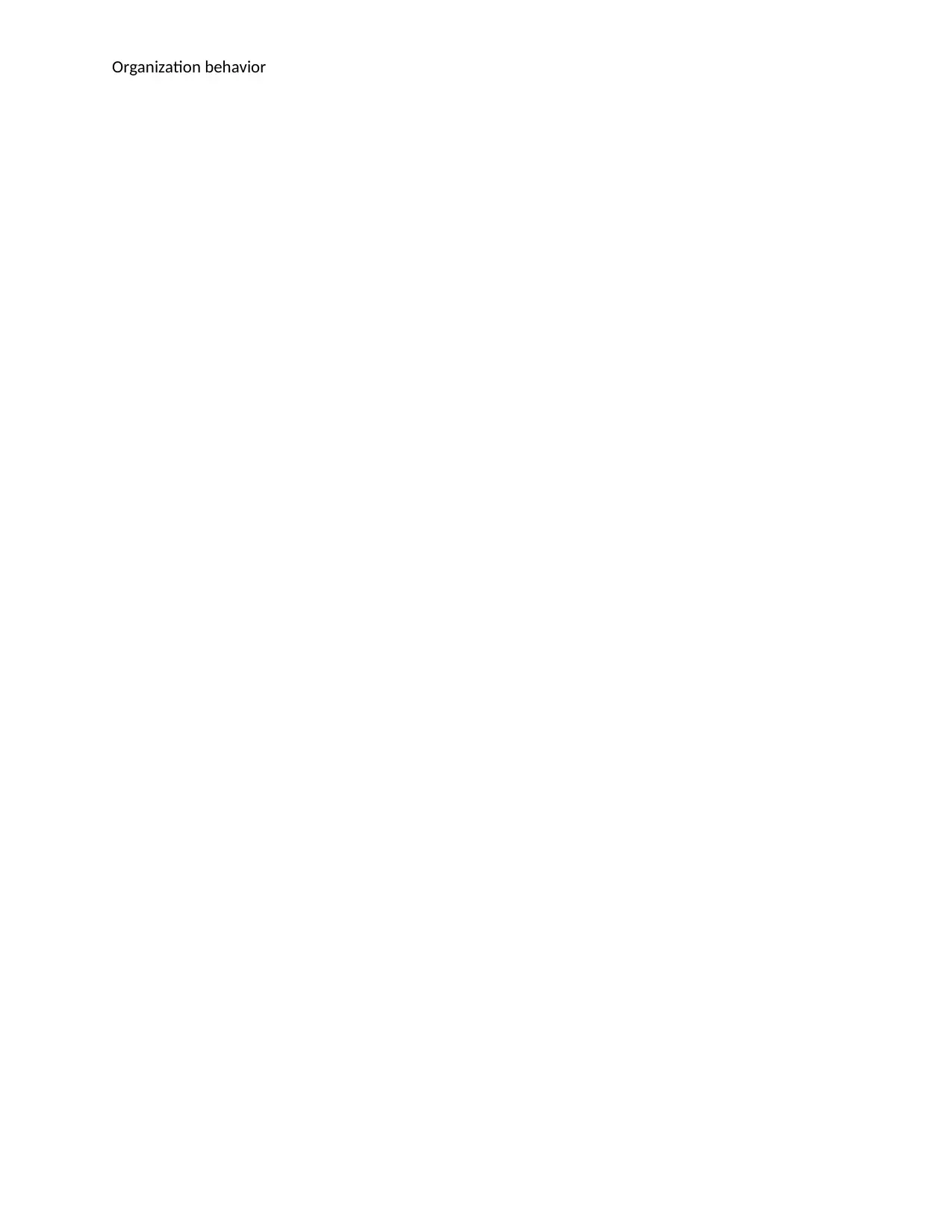
Organization behavior
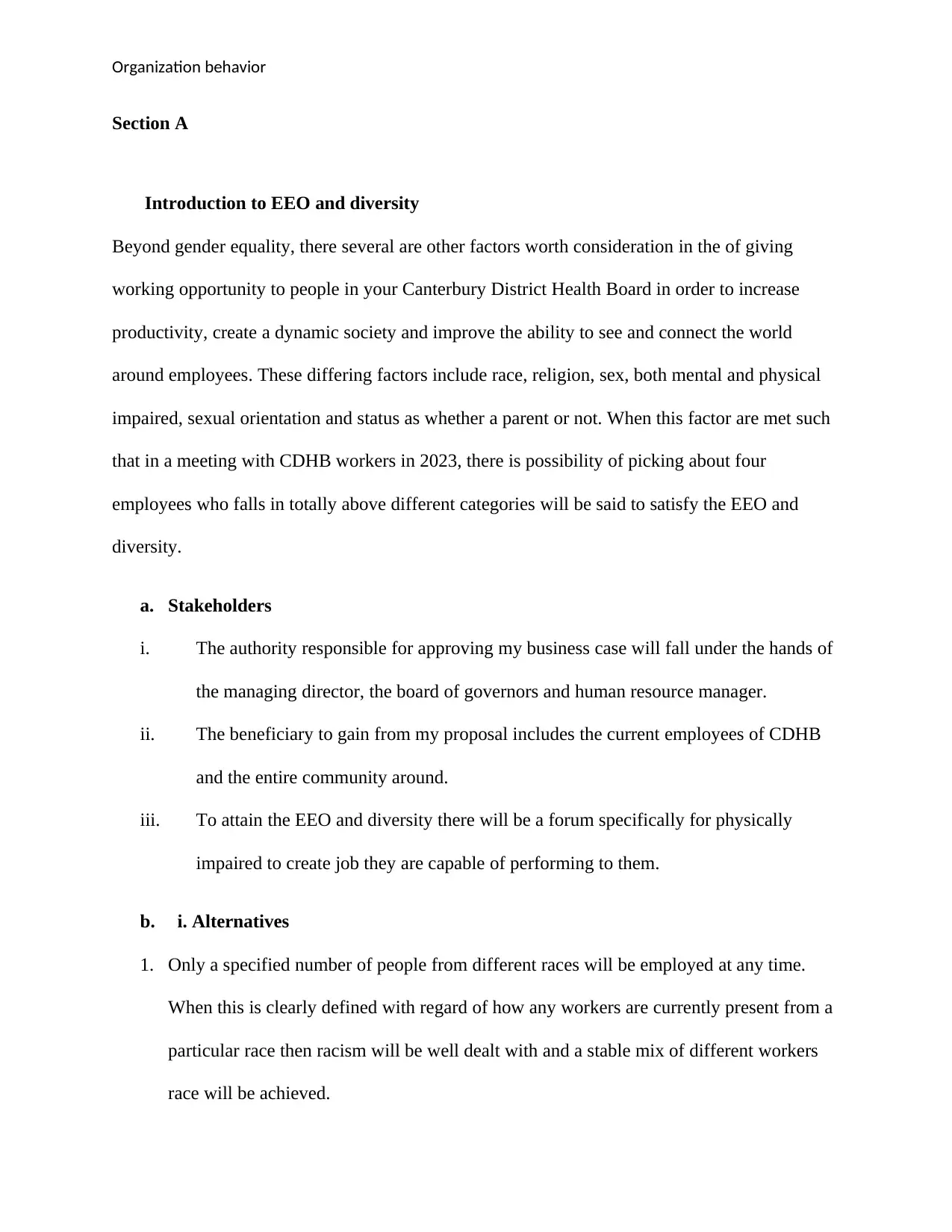
Organization behavior
Section A
Introduction to EEO and diversity
Beyond gender equality, there several are other factors worth consideration in the of giving
working opportunity to people in your Canterbury District Health Board in order to increase
productivity, create a dynamic society and improve the ability to see and connect the world
around employees. These differing factors include race, religion, sex, both mental and physical
impaired, sexual orientation and status as whether a parent or not. When this factor are met such
that in a meeting with CDHB workers in 2023, there is possibility of picking about four
employees who falls in totally above different categories will be said to satisfy the EEO and
diversity.
a. Stakeholders
i. The authority responsible for approving my business case will fall under the hands of
the managing director, the board of governors and human resource manager.
ii. The beneficiary to gain from my proposal includes the current employees of CDHB
and the entire community around.
iii. To attain the EEO and diversity there will be a forum specifically for physically
impaired to create job they are capable of performing to them.
b. i. Alternatives
1. Only a specified number of people from different races will be employed at any time.
When this is clearly defined with regard of how any workers are currently present from a
particular race then racism will be well dealt with and a stable mix of different workers
race will be achieved.
Section A
Introduction to EEO and diversity
Beyond gender equality, there several are other factors worth consideration in the of giving
working opportunity to people in your Canterbury District Health Board in order to increase
productivity, create a dynamic society and improve the ability to see and connect the world
around employees. These differing factors include race, religion, sex, both mental and physical
impaired, sexual orientation and status as whether a parent or not. When this factor are met such
that in a meeting with CDHB workers in 2023, there is possibility of picking about four
employees who falls in totally above different categories will be said to satisfy the EEO and
diversity.
a. Stakeholders
i. The authority responsible for approving my business case will fall under the hands of
the managing director, the board of governors and human resource manager.
ii. The beneficiary to gain from my proposal includes the current employees of CDHB
and the entire community around.
iii. To attain the EEO and diversity there will be a forum specifically for physically
impaired to create job they are capable of performing to them.
b. i. Alternatives
1. Only a specified number of people from different races will be employed at any time.
When this is clearly defined with regard of how any workers are currently present from a
particular race then racism will be well dealt with and a stable mix of different workers
race will be achieved.
⊘ This is a preview!⊘
Do you want full access?
Subscribe today to unlock all pages.

Trusted by 1+ million students worldwide
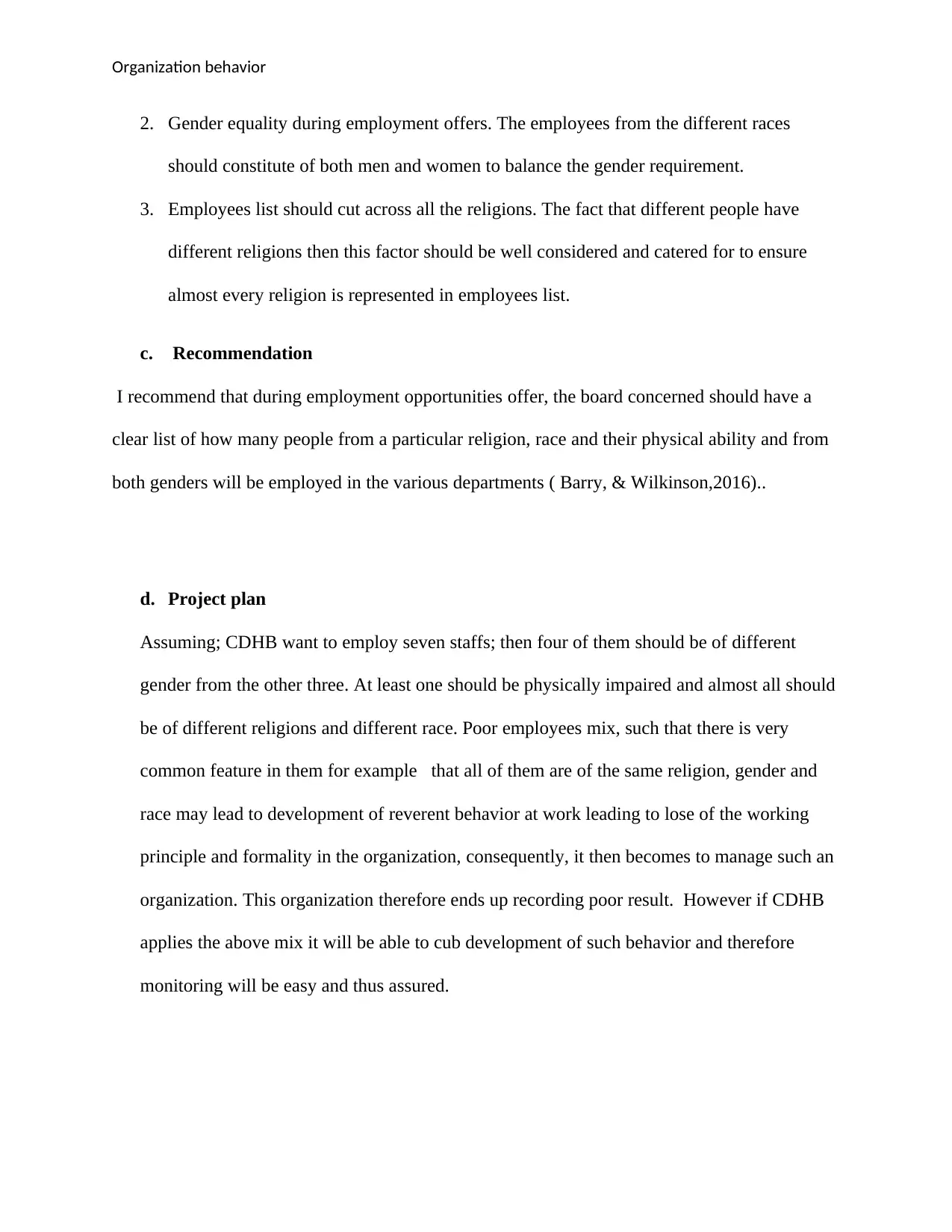
Organization behavior
2. Gender equality during employment offers. The employees from the different races
should constitute of both men and women to balance the gender requirement.
3. Employees list should cut across all the religions. The fact that different people have
different religions then this factor should be well considered and catered for to ensure
almost every religion is represented in employees list.
c. Recommendation
I recommend that during employment opportunities offer, the board concerned should have a
clear list of how many people from a particular religion, race and their physical ability and from
both genders will be employed in the various departments ( Barry, & Wilkinson,2016)..
d. Project plan
Assuming; CDHB want to employ seven staffs; then four of them should be of different
gender from the other three. At least one should be physically impaired and almost all should
be of different religions and different race. Poor employees mix, such that there is very
common feature in them for example that all of them are of the same religion, gender and
race may lead to development of reverent behavior at work leading to lose of the working
principle and formality in the organization, consequently, it then becomes to manage such an
organization. This organization therefore ends up recording poor result. However if CDHB
applies the above mix it will be able to cub development of such behavior and therefore
monitoring will be easy and thus assured.
2. Gender equality during employment offers. The employees from the different races
should constitute of both men and women to balance the gender requirement.
3. Employees list should cut across all the religions. The fact that different people have
different religions then this factor should be well considered and catered for to ensure
almost every religion is represented in employees list.
c. Recommendation
I recommend that during employment opportunities offer, the board concerned should have a
clear list of how many people from a particular religion, race and their physical ability and from
both genders will be employed in the various departments ( Barry, & Wilkinson,2016)..
d. Project plan
Assuming; CDHB want to employ seven staffs; then four of them should be of different
gender from the other three. At least one should be physically impaired and almost all should
be of different religions and different race. Poor employees mix, such that there is very
common feature in them for example that all of them are of the same religion, gender and
race may lead to development of reverent behavior at work leading to lose of the working
principle and formality in the organization, consequently, it then becomes to manage such an
organization. This organization therefore ends up recording poor result. However if CDHB
applies the above mix it will be able to cub development of such behavior and therefore
monitoring will be easy and thus assured.
Paraphrase This Document
Need a fresh take? Get an instant paraphrase of this document with our AI Paraphraser
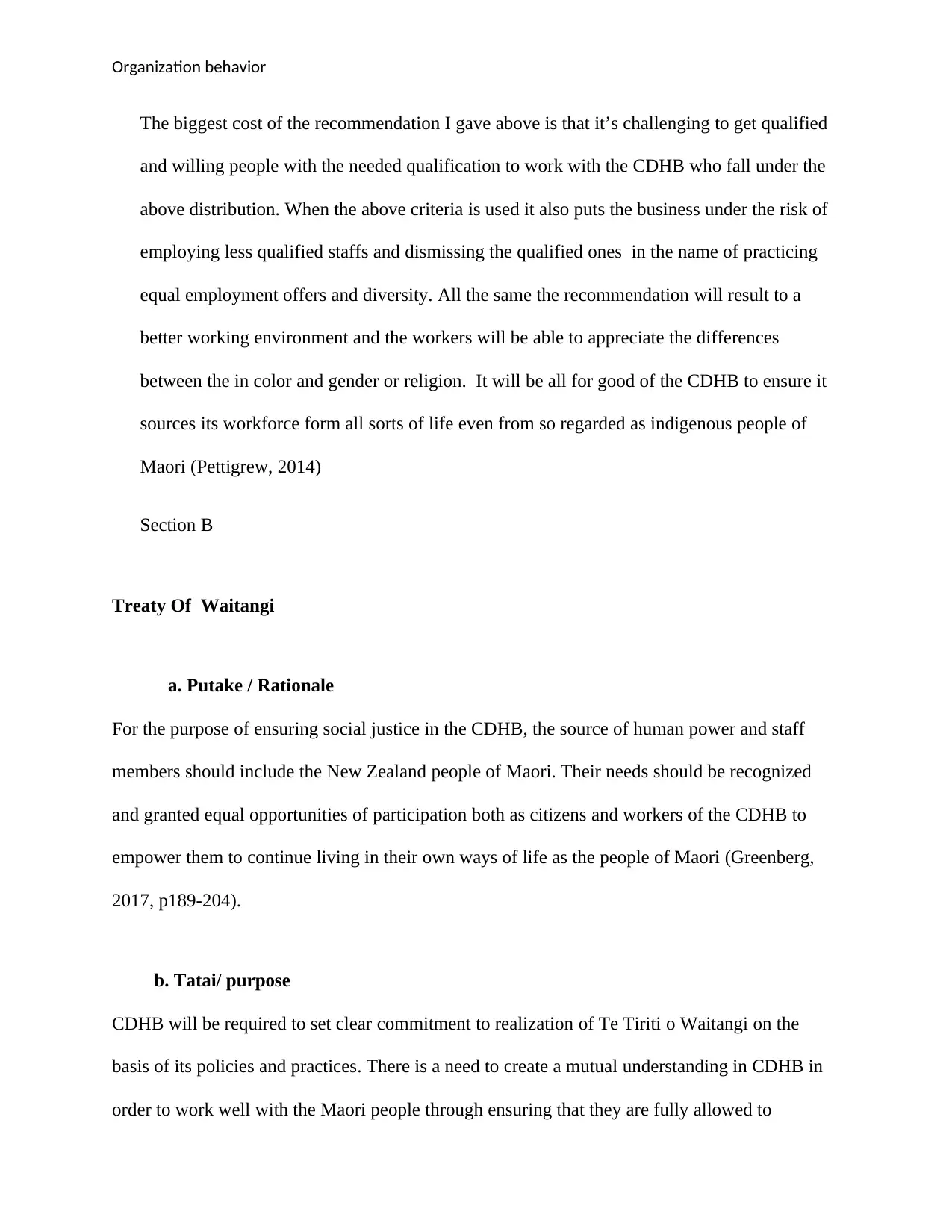
Organization behavior
The biggest cost of the recommendation I gave above is that it’s challenging to get qualified
and willing people with the needed qualification to work with the CDHB who fall under the
above distribution. When the above criteria is used it also puts the business under the risk of
employing less qualified staffs and dismissing the qualified ones in the name of practicing
equal employment offers and diversity. All the same the recommendation will result to a
better working environment and the workers will be able to appreciate the differences
between the in color and gender or religion. It will be all for good of the CDHB to ensure it
sources its workforce form all sorts of life even from so regarded as indigenous people of
Maori (Pettigrew, 2014)
Section B
Treaty Of Waitangi
a. Putake / Rationale
For the purpose of ensuring social justice in the CDHB, the source of human power and staff
members should include the New Zealand people of Maori. Their needs should be recognized
and granted equal opportunities of participation both as citizens and workers of the CDHB to
empower them to continue living in their own ways of life as the people of Maori (Greenberg,
2017, p189-204).
b. Tatai/ purpose
CDHB will be required to set clear commitment to realization of Te Tiriti o Waitangi on the
basis of its policies and practices. There is a need to create a mutual understanding in CDHB in
order to work well with the Maori people through ensuring that they are fully allowed to
The biggest cost of the recommendation I gave above is that it’s challenging to get qualified
and willing people with the needed qualification to work with the CDHB who fall under the
above distribution. When the above criteria is used it also puts the business under the risk of
employing less qualified staffs and dismissing the qualified ones in the name of practicing
equal employment offers and diversity. All the same the recommendation will result to a
better working environment and the workers will be able to appreciate the differences
between the in color and gender or religion. It will be all for good of the CDHB to ensure it
sources its workforce form all sorts of life even from so regarded as indigenous people of
Maori (Pettigrew, 2014)
Section B
Treaty Of Waitangi
a. Putake / Rationale
For the purpose of ensuring social justice in the CDHB, the source of human power and staff
members should include the New Zealand people of Maori. Their needs should be recognized
and granted equal opportunities of participation both as citizens and workers of the CDHB to
empower them to continue living in their own ways of life as the people of Maori (Greenberg,
2017, p189-204).
b. Tatai/ purpose
CDHB will be required to set clear commitment to realization of Te Tiriti o Waitangi on the
basis of its policies and practices. There is a need to create a mutual understanding in CDHB in
order to work well with the Maori people through ensuring that they are fully allowed to
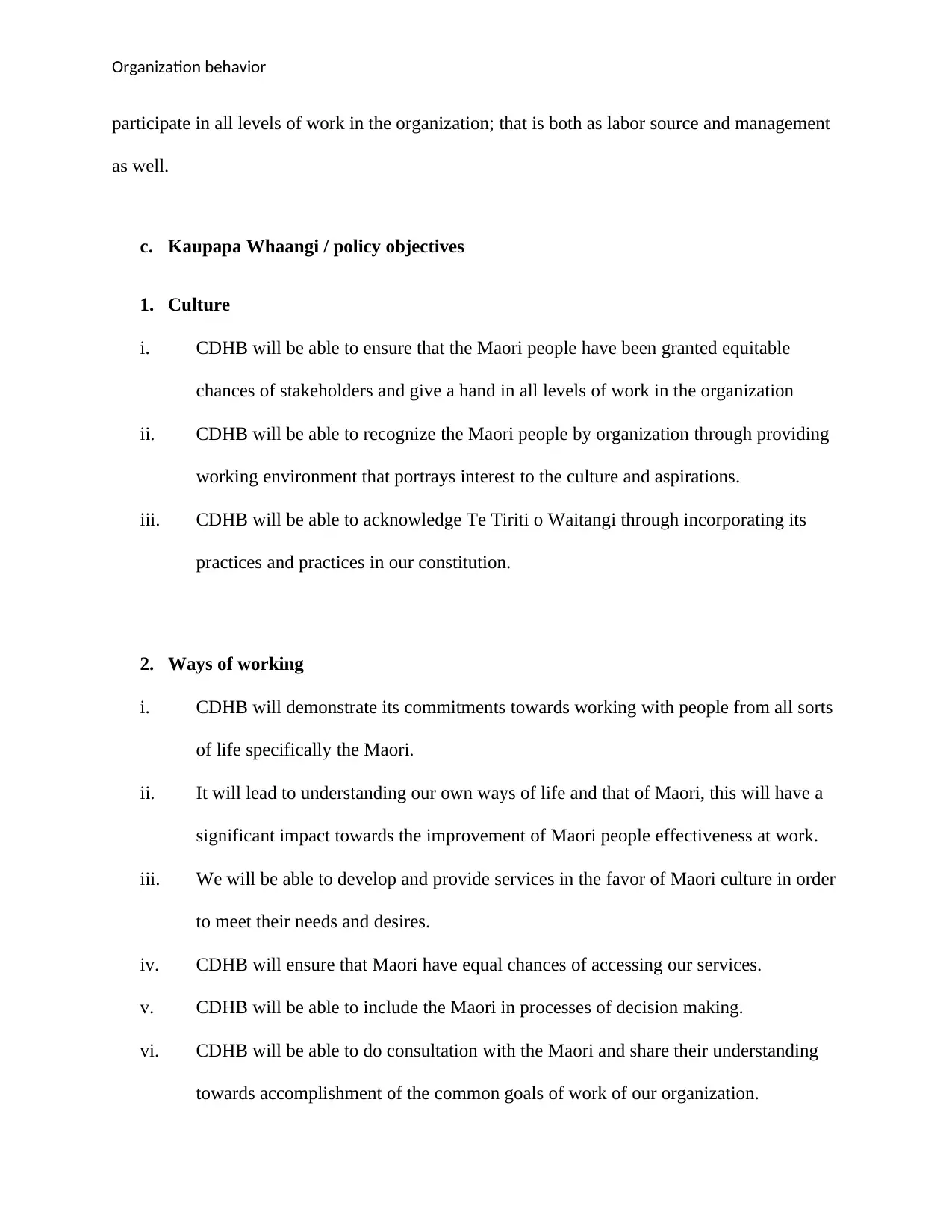
Organization behavior
participate in all levels of work in the organization; that is both as labor source and management
as well.
c. Kaupapa Whaangi / policy objectives
1. Culture
i. CDHB will be able to ensure that the Maori people have been granted equitable
chances of stakeholders and give a hand in all levels of work in the organization
ii. CDHB will be able to recognize the Maori people by organization through providing
working environment that portrays interest to the culture and aspirations.
iii. CDHB will be able to acknowledge Te Tiriti o Waitangi through incorporating its
practices and practices in our constitution.
2. Ways of working
i. CDHB will demonstrate its commitments towards working with people from all sorts
of life specifically the Maori.
ii. It will lead to understanding our own ways of life and that of Maori, this will have a
significant impact towards the improvement of Maori people effectiveness at work.
iii. We will be able to develop and provide services in the favor of Maori culture in order
to meet their needs and desires.
iv. CDHB will ensure that Maori have equal chances of accessing our services.
v. CDHB will be able to include the Maori in processes of decision making.
vi. CDHB will be able to do consultation with the Maori and share their understanding
towards accomplishment of the common goals of work of our organization.
participate in all levels of work in the organization; that is both as labor source and management
as well.
c. Kaupapa Whaangi / policy objectives
1. Culture
i. CDHB will be able to ensure that the Maori people have been granted equitable
chances of stakeholders and give a hand in all levels of work in the organization
ii. CDHB will be able to recognize the Maori people by organization through providing
working environment that portrays interest to the culture and aspirations.
iii. CDHB will be able to acknowledge Te Tiriti o Waitangi through incorporating its
practices and practices in our constitution.
2. Ways of working
i. CDHB will demonstrate its commitments towards working with people from all sorts
of life specifically the Maori.
ii. It will lead to understanding our own ways of life and that of Maori, this will have a
significant impact towards the improvement of Maori people effectiveness at work.
iii. We will be able to develop and provide services in the favor of Maori culture in order
to meet their needs and desires.
iv. CDHB will ensure that Maori have equal chances of accessing our services.
v. CDHB will be able to include the Maori in processes of decision making.
vi. CDHB will be able to do consultation with the Maori and share their understanding
towards accomplishment of the common goals of work of our organization.
⊘ This is a preview!⊘
Do you want full access?
Subscribe today to unlock all pages.

Trusted by 1+ million students worldwide

Organization behavior
3. Human resource and workforce development
i. CDHB will conduct recruitment to the Maori people and source their work force
ii. CDHB will make sure that it recruitment process and rules are conducive to the Maori
and that they have an active inclusion in them.
iii. Through this CDHB will be able to ensure that it provide a working environment that
put the Maori culture into consideration to enable them undertake their duties at work
and purse their Aspirations and interest.
iv. CDHB will equip its Maori staffs with equal opportunity and support them to develop
knowledge and awareness of their own culture.
Section c
Alignment
1. Parallel leaning
The X-stream executive officer Gil Reihana should d ensures that the formality of work is
restored in terms of management and departments are well organized to cope with the challenge
staffs resignation. From the context it is evident that an accountant resigns two years later due to
what he referred as poor organization of the department. The relationship between workers and
work will need to formalized with defined work arrival and leaving time unlike in the above case
where some workers argue that they do their better part of work at home (Chughtai, Byrne, &
Flood, 2015,p653-663).
3. Human resource and workforce development
i. CDHB will conduct recruitment to the Maori people and source their work force
ii. CDHB will make sure that it recruitment process and rules are conducive to the Maori
and that they have an active inclusion in them.
iii. Through this CDHB will be able to ensure that it provide a working environment that
put the Maori culture into consideration to enable them undertake their duties at work
and purse their Aspirations and interest.
iv. CDHB will equip its Maori staffs with equal opportunity and support them to develop
knowledge and awareness of their own culture.
Section c
Alignment
1. Parallel leaning
The X-stream executive officer Gil Reihana should d ensures that the formality of work is
restored in terms of management and departments are well organized to cope with the challenge
staffs resignation. From the context it is evident that an accountant resigns two years later due to
what he referred as poor organization of the department. The relationship between workers and
work will need to formalized with defined work arrival and leaving time unlike in the above case
where some workers argue that they do their better part of work at home (Chughtai, Byrne, &
Flood, 2015,p653-663).
Paraphrase This Document
Need a fresh take? Get an instant paraphrase of this document with our AI Paraphraser

Organization behavior
Large group intervention
During the meetings there should be a well-defined program of conduct to cub the current case
where the meetings starts with mere joke that are not lightly taken by those its aired off. Jokes
should be abolished; its evident from the study work above it could contribute to by attending of
meetings by some employee especially who has at some time not taken the joke addressed to
them. The formal workers relation will help to cub indiscipline cases evident in context where
Don Head a marketing manager sexually assaulted a 22years old secretary and the case was
dropped after she was bribed with a huge amount of money. Although head is a man of bad
behaviors, he has once spread bad rumors about the competing products and even their
companies to cub competition; there is high probability that this was contributed seducing and
tempting wear of the secretary (Gyekye & Haybatollahi, 2015,p112-120).
Decision making process should be dropped from the consensus style to new style where
decisions are made from the top to bottom and the implementation of the decisions is followed
up rather than where the managers are left do it alone with their staffs. This will eliminate cases
like where Jason Palu forces employees to work on overtimes.
2. Cohesive approach to align the organization
Arrival time at work should be specified. This is part of discipline, and for the offender I will
allocate a disciplinary committee to deal with it together with sexual assaults and any other
kind of an abuse. In this conjunction I will define the dress code requirement that an
individual should meet at any working day. Proper dressing will reduce temptation to sex act.
Therefore this will reduce conflict of sexual harassment (McShane, Steen, & Tasa, 2009).
Large group intervention
During the meetings there should be a well-defined program of conduct to cub the current case
where the meetings starts with mere joke that are not lightly taken by those its aired off. Jokes
should be abolished; its evident from the study work above it could contribute to by attending of
meetings by some employee especially who has at some time not taken the joke addressed to
them. The formal workers relation will help to cub indiscipline cases evident in context where
Don Head a marketing manager sexually assaulted a 22years old secretary and the case was
dropped after she was bribed with a huge amount of money. Although head is a man of bad
behaviors, he has once spread bad rumors about the competing products and even their
companies to cub competition; there is high probability that this was contributed seducing and
tempting wear of the secretary (Gyekye & Haybatollahi, 2015,p112-120).
Decision making process should be dropped from the consensus style to new style where
decisions are made from the top to bottom and the implementation of the decisions is followed
up rather than where the managers are left do it alone with their staffs. This will eliminate cases
like where Jason Palu forces employees to work on overtimes.
2. Cohesive approach to align the organization
Arrival time at work should be specified. This is part of discipline, and for the offender I will
allocate a disciplinary committee to deal with it together with sexual assaults and any other
kind of an abuse. In this conjunction I will define the dress code requirement that an
individual should meet at any working day. Proper dressing will reduce temptation to sex act.
Therefore this will reduce conflict of sexual harassment (McShane, Steen, & Tasa, 2009).
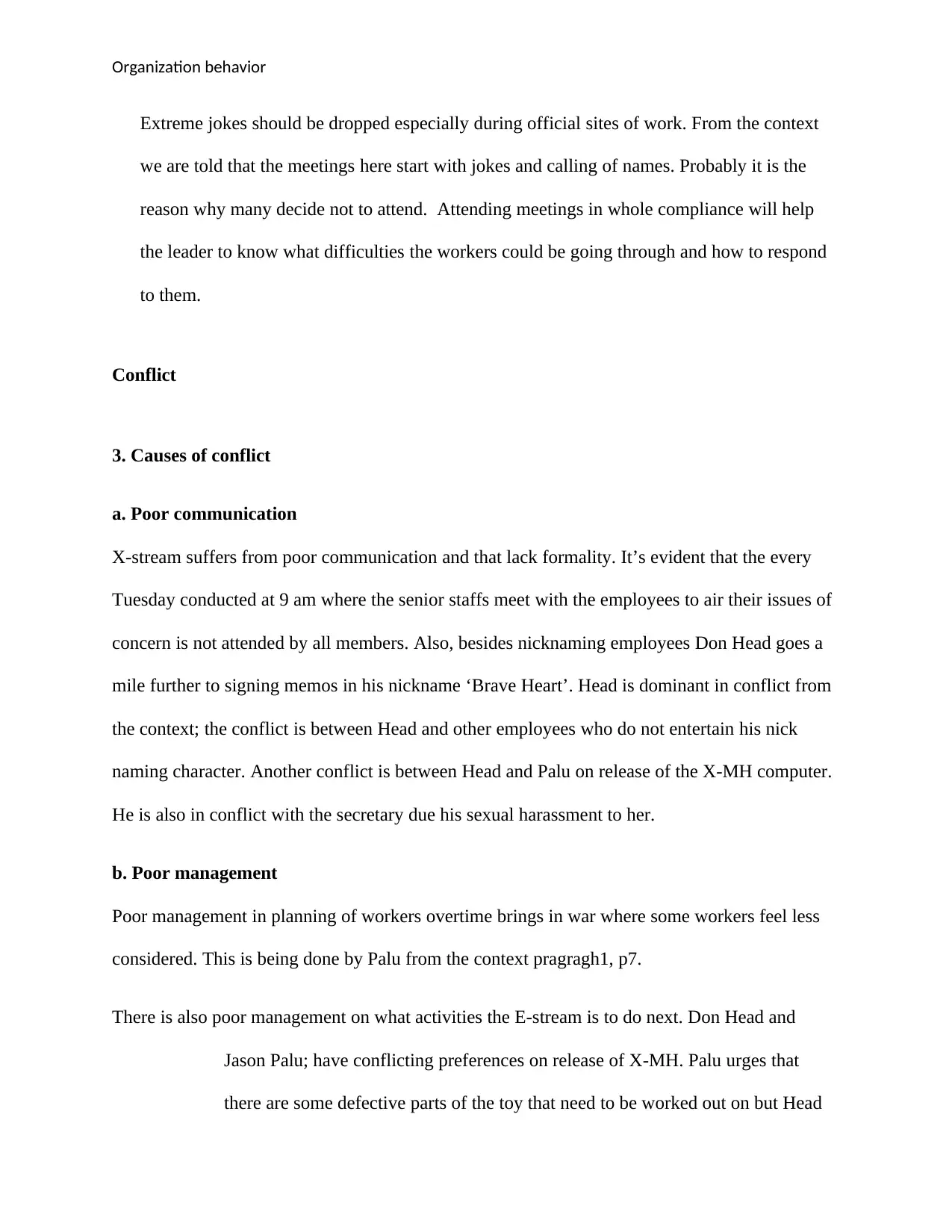
Organization behavior
Extreme jokes should be dropped especially during official sites of work. From the context
we are told that the meetings here start with jokes and calling of names. Probably it is the
reason why many decide not to attend. Attending meetings in whole compliance will help
the leader to know what difficulties the workers could be going through and how to respond
to them.
Conflict
3. Causes of conflict
a. Poor communication
X-stream suffers from poor communication and that lack formality. It’s evident that the every
Tuesday conducted at 9 am where the senior staffs meet with the employees to air their issues of
concern is not attended by all members. Also, besides nicknaming employees Don Head goes a
mile further to signing memos in his nickname ‘Brave Heart’. Head is dominant in conflict from
the context; the conflict is between Head and other employees who do not entertain his nick
naming character. Another conflict is between Head and Palu on release of the X-MH computer.
He is also in conflict with the secretary due his sexual harassment to her.
b. Poor management
Poor management in planning of workers overtime brings in war where some workers feel less
considered. This is being done by Palu from the context pragragh1, p7.
There is also poor management on what activities the E-stream is to do next. Don Head and
Jason Palu; have conflicting preferences on release of X-MH. Palu urges that
there are some defective parts of the toy that need to be worked out on but Head
Extreme jokes should be dropped especially during official sites of work. From the context
we are told that the meetings here start with jokes and calling of names. Probably it is the
reason why many decide not to attend. Attending meetings in whole compliance will help
the leader to know what difficulties the workers could be going through and how to respond
to them.
Conflict
3. Causes of conflict
a. Poor communication
X-stream suffers from poor communication and that lack formality. It’s evident that the every
Tuesday conducted at 9 am where the senior staffs meet with the employees to air their issues of
concern is not attended by all members. Also, besides nicknaming employees Don Head goes a
mile further to signing memos in his nickname ‘Brave Heart’. Head is dominant in conflict from
the context; the conflict is between Head and other employees who do not entertain his nick
naming character. Another conflict is between Head and Palu on release of the X-MH computer.
He is also in conflict with the secretary due his sexual harassment to her.
b. Poor management
Poor management in planning of workers overtime brings in war where some workers feel less
considered. This is being done by Palu from the context pragragh1, p7.
There is also poor management on what activities the E-stream is to do next. Don Head and
Jason Palu; have conflicting preferences on release of X-MH. Palu urges that
there are some defective parts of the toy that need to be worked out on but Head
⊘ This is a preview!⊘
Do you want full access?
Subscribe today to unlock all pages.

Trusted by 1+ million students worldwide
1 out of 18
Related Documents
Your All-in-One AI-Powered Toolkit for Academic Success.
+13062052269
info@desklib.com
Available 24*7 on WhatsApp / Email
![[object Object]](/_next/static/media/star-bottom.7253800d.svg)
Unlock your academic potential
Copyright © 2020–2025 A2Z Services. All Rights Reserved. Developed and managed by ZUCOL.





